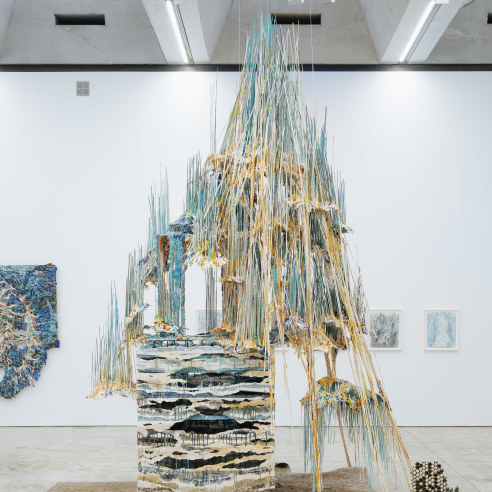
Diana Al-Hadid’s first solo exhibition with the gallery, Women, Bronze, and Dangerous Things, spans both 509 West 27th Street and the Kasmin Sculpture Garden from November 2–December 22, 2023. Featuring an extensive new body of work developed over the last five years, the exhibition underscores the artist’s singular approach to relief and large-scale sculpture alongside a new series of mixed media drawings on Mylar, as well as works on paper pulp developed as part of her residency at Dieu Donné, New York. Known for her evocative transformations of industrial materials such as fiberglass, gypsum, steel, and bronze, Al-Hadid’s works engage with thematic references across the fields of antiquity, folklore, architecture, manuscripts, cartography, and cosmology, among other subjects, as a way of communing with the present.
Across Al-Hadid’s use of motifs in this exhibition—which includes figures from Greek mythology alongside protagonists in Islamic and Christian narratives—the artist’s contemporary interpretations intuitively navigate different attempts of reading the future through our past. Constructions in nature such as mountains and caves reappear as emblematic elements of landscape tied to the social, psychological, and religious narratives that have been absorbed into dominant culture over the centuries. Indifferent to where these narratives find their origin in theology, Al-Hadid’s method of retrieving stories both communicate with history and imagine them anew. At once prophetic and autobiographical, Al-Hadid’s sensitive installation across two sites of the gallery’s architecture articulates a realm that manifests, both physically and metaphorically, above ground and below.
The exhibition title borrows its structure from a book by American linguist and philosopher George Lakoff, Women, Fire, and Dangerous Things: What Categories Reveal About the Mind, published in 1987. Citing the importance of categorization to human cognition, a necessary impulse in the development of the psyche and the evolution of our species, Al-Hadid considers the complex facets of identity and understanding intrinsic to the immigrant experience. How does one categorize ‘home’ when they no longer occupy the land in which they were born? Do the origin stories of that site belong to one that identifies with, and without, a nation? Across Al-Hadid’s works present in this installation, we return to the question of how selves that exist on the threshold of classification interact with history.